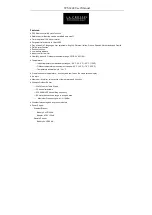
27
26
COLORIS –
Wireless weather station
6. Getting started
• Place the base station and the transmitter on a table at a distance of about 1.5 meters from each other. Avoid being close to possible sources
of interference such as electronic devices and radio equipment.
• Open the transmitter's battery compartment.
• Insert two new AA 1,5 V batteries, polarity as illustrated.
• Close the battery compartment carefully.
• Connect the attached power adapter to the base station. Insert the adapter into the base station jack and connect the power adapter into a
mains socket.
Important!
Make sure that your household voltage is no more than 230V! Otherwise your device may be damaged.
• All segments will be displayed briefly and subsequently the version number of the software.
• The indoor temperature and humidity appear on the base station display.
6.1 Outdoor values reception
• The base station will scan the outdoor values of the transmitter. The reception symbol flashes. If the reception is successful, the outdoor
temperature and humidity appear on the base station display.
• If the reception of the outdoor values fails, “- -” appears on the base station display. Check the batteries and try it again. Check if there is any
source of interference.
• As soon as the base station receives the radio-controlled time, you can start the manual initialization of the transmitter. Press and hold the
COLOR MODE
button for 3 seconds.
6.2 Radio-controlled time reception
• After the base station has completed the search for the transmitter, the device starts scanning the DCF signal (radio signal) and the DCF
reception symbol flashes.
COLORIS –
Wireless weather station
• When the time code is successfully received after 2-12 minutes, the radio-controlled time and the DCF symbol will be shown steadily on the
display.
• The clock receives the signal twice a day (2:00 and 3:00 am). If the reception fails, scanning stops and will be repeated every hour. If the
reception is not successfully received until 6:00 o'clock, the next DCF reception attempt will happen at 2:00 o'clock in the following morning.
• If the clock cannot detect the DCF-signal (e.g. due to interference, transmitting distance, etc.), the time can be set manually. The DCF recep-
tion symbol disappears and the clock will then work as a normal quartz clock (see: Manual settings).
• There are three different reception symbols:
Symbol flashing – reception is active
Symbol solid – reception is very good
no symbol – reception is deactivated/turned off
6.3 Note on radio-controlled time
The time base for the radio-controlled time is a caesium atomic clock operated by the Physikalisch Technische Bundesanstalt based in Braunschweig
(Brunswick), Germany. It has a time deviation of less than one second in one million years. The time is coded and transmitted from Mainflingen near
Frankfurt via the frequency signal DCF-77 (77.5 kHz) and has a transmitting range of approximately 1,500 km. Your radio clock receives the signal,
converts it and always shows the exact time. The adjustment to Daylight Saving Time (summer/winter time) is automatic. The reception quality
depends mainly on geographic location. Normally there should be no reception problems within a 1,500 km radius around Frankfurt.
Therefore, please note the following steps:
• The recommended distance to any interfering sources like computer screens or TV sets is at least 1.5 - 2 meters.
• Within concrete walls (reinforced with steel) such as basements, the received signal is naturally weakened. In extreme cases, please place the
unit close to a window to improve reception.
TFA_No. 35.1147_Anleitung 06.10.2017 9:33 Uhr Seite 14















































